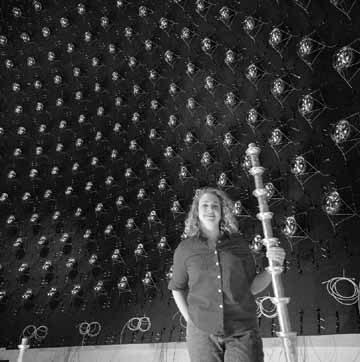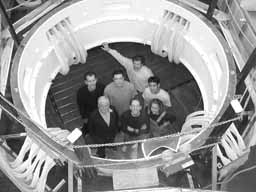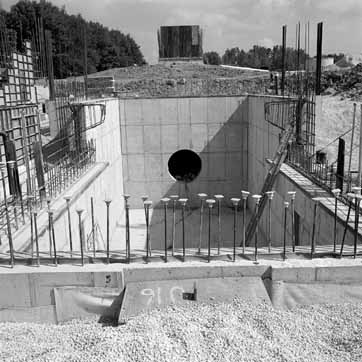 |
|
MiniBooNE Opens its "Eyes" by Kurt Riesselmann
In the last six months the MiniBooNE collaboration, intent on detecting moving particles, has created a compound "eye" of its own. Project scientists have outfitted a 40-foot spherical tank with more than a thousand photomultiplier tubes (PMTs), special light-sensitive devices shaped like large deformed light bulbs.
"When we are done," said physicist Fernanda G. Garcia, who assists in coordinating the detector installation, "the tank will have one thousand five hundred and twenty PMTs."
Unlike the arrangement of an insect's eye, the MiniBooNE's photosensors cover the inside of the sphere, pointing to the center of the tank, which experimenters will fill with 250,000 gallons of mineral oil. That's where they expect the action to be: flashes of light that occur as neutrinos collide with oil molecules.
Scientists know very little about neutrinos, especially about their mass. Although neutrinos are expected to have only a minuscule mass, their abundance makes it possible that the total mass of all neutrinos in our universe may be larger than the combined mass of all stars.
Beginning February 2001, collaboration members from Princeton University have been installing two layers of photomultipliers, separated by an optical barrier, inside the tank. About one sixth of all PMTs sit between the tank's wall and the barrier: they will record charged particles entering the tank from the outside. All other PMTs are on the inside of the barrier: they will identify the charged particles stemming from neutrino-oil collisions.
Building the structure of barrier panels and PMTs inside the tank "is different from assembling something on a bench top," said Bill Sands, the Princeton engineer who designed the support structure for the PMTs.
"Due to space restriction, there is no crane access inside the tank," Sands explained. "Since everything has to be handled by people, we decided to use the lightest materials possible. The barrier panels, which hold the photomultipliers, are made of aluminum. Steel struts mounted to the tank bear the load of the whole structure."
The first challenge occurred even before the Princeton group began the installation.
"I had trouble finding a company to put up scaffolding inside the spherical tank," remembers Sands. "I called people at various companies and they laughed at me."
Sands and his colleagues finally found a contractor who took the job seriously. Now they are getting ready to finish the PMT installation at the end of August.
Recycled equipment
"We've also shipped parts of the electronics from Los Alamos to Fermilab," he said. "MiniBooNE will use the same amplifiers as the LSND experiment. The computers and software, however, will be different."
MiniBooNE expects to install and connect all electronics before the end of September.
"Different companies put in bids for the 250,000-gallon oil contract," she said. "They all must submit a ten-gallon sample. Without knowing from which company they came, I'm testing the properties of the different samples."
The MiniBooNE collaboration has scheduled the oil delivery for the end of October, when more than 30 tank trucks will come to Fermilab. The oil of every truck will be tested before it is pumped into the detector.
Bill Louis, cospokesperson of the collaboration, expects the detector to be fully operational by December. Physicists will then begin taking data using cosmic rays to tune the detector electronics. According to Louis, the first neutrino beam, created by Fermilab's accelerators, will traverse the detector in the spring. The high-intensity beam will cause a neutrino collision inside the tank about every twenty seconds.
The MiniBooNE experiment will collect much more data than LSND, yielding much better statistics, due to a stronger neutrino beam and hence higher event rates. A significant advantage of the Fermilab accelerator is a smaller pulse duration: the MiniBooNE neutrino beam will consist of very short high-intensity pulses, about 10,000 times shorter than the LSND beam. This greatly improves the experiment's capability of separating beam-induced neutrino events from naturally occurring cosmic-ray interactions, which take place at random times.
The MiniBooNE collaboration, consisting of about 50 physicists from 14 universities and laboratories, is eager to start its experiment. Confirming the LSND result would indicate the existence of an additional kind of neutrino beyond the three known flavors, which would in turn require physicists to rewrite a large part of the theoretical framework called the Standard Model.
"It would be fun to see a lot of people scrambling to try to explain a positive outcome," said Princeton physicist Peter Meyers, member of the MiniBooNE collaboration.
On the Web:
Neutrino oscillations--What it all means:
Streaming video on Cerenkov light (5 min):
|
| last modified 8/11/2001 by C. Hebert email Fermilab |
FRLsDFx9eyfrPXgV
 The fly, like many insects, has a compound eye consisting of thousands of separate facets spread over the surface of a sphere. Each unit is sensitive to light and produces its own image, making the compound eye an excellent tool to detect moving objects.
The fly, like many insects, has a compound eye consisting of thousands of separate facets spread over the surface of a sphere. Each unit is sensitive to light and produces its own image, making the compound eye an excellent tool to detect moving objects.

 Observing neutrinos requires large detectors and great patience. Neutrinos are able to cross the entire universe, traversing space, planets, galaxies at almost the speed of light, without leaving a mark. Only the extremely rare collision with the core of an atom stops a neutrino and reveals its presence, transforming it into a charged particle. Depending on the type of neutrino hitting an atom, either an electron or a similar but heavier particle emerges from the collision. Physicists can detect light emitted by the charged particle, thereby learning more about the properties of the initial neutrino.
Observing neutrinos requires large detectors and great patience. Neutrinos are able to cross the entire universe, traversing space, planets, galaxies at almost the speed of light, without leaving a mark. Only the extremely rare collision with the core of an atom stops a neutrino and reveals its presence, transforming it into a charged particle. Depending on the type of neutrino hitting an atom, either an electron or a similar but heavier particle emerges from the collision. Physicists can detect light emitted by the charged particle, thereby learning more about the properties of the initial neutrino.
 "Inserting the final panels will be very tricky," said Garcia. "But they know how to do it."
"Inserting the final panels will be very tricky," said Garcia. "But they know how to do it."